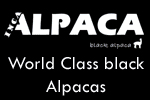Articles by Alpaca World Magazine:
The Hype About Micron
John Gaye
To the textile trade micron is the most important criteria for paying any sort of premium on fibre. To the maker of clothes the finer the diameter, the more valuable a fleece will be. It gives the textile manufacturer the opportunity to make a finer yarn, thus better quality garments, and more opportunity to market their products with a higher price tag. However to the breeder of alpacas it is not the only criteria on which to assess an animal and its fleece. Indeed the histogram with all its statistics will only tell one small part of the overall story.
The assessment of an alpaca and its fleece in my opinion has to be done on a broader basis. There are a number of important criteria which must be considered and only when all the various factors are assessed can a breeder really know whether they have got an animal of real value, rather than just an animal marketed with micron hype.
But micron is one important element in the selection process. Fineness of fibre is a highly hereditable characteristic and should not be underestimated for its value in any breeding programme. But has that fineness of micron been as a result of environmental factors or through strong genetics? If the assessor can identify that the parents have fineness, or even better the grandparents, then that is a really valuable measure because assessment by fineness should be a genetic trait not a phenotypical one. If, when the animal with 15 microns at 2 years old reaches five years of age, the micron level takes a huge dive then the owner of that animal is going to be very disappointed and the only way to ensure a degree of certainty is to know the genetic background to that animal.
Vicuña fibre is probably the finest fibre in the world, usually at under 14 microns. Alpacas, being descendants of those beautiful animals, can aspire to that sort of fineness. However the yield from a vicuña is small, usually much less than 0.5 kg per animal even though they are only shorn every second year. And although the value of their fibre is very high indeed (over £200 per kg) you would need a lot of them to fill a bale.
What a breeder requires is a balance of all the qualities in order to contribute towards their goal of the perfect alpaca, if such an animal exists.
Yield is important to the breeder, so density and staple length, both of which are highly hereditable, and any other attribute which contributes to that increase in yield, are going to be just as important as fineness. Density can be measured objectively by weighing the fleece after 12 months growth or subjectively by the eye and by hand. If, when you press your hand against the side of the animal, it does not yield to pressure then that is dense. If you have an overall fleece weight of over 3 kgs then that is a reasonable animal. If it ‘cuts’ 4 or 5 kgs then you are really looking at something rather more impressive. Remember though that to compare fleece weights between an 11 month fleece and a 14 month fleece could be very misleading.
Also contributing to yield is the staple length. If an alpaca is pre-disposed to grow a longer staple length in one year then it is bound to yield more. However this is difficult for someone assessing the quality of an animal unless they own it and can assess it over the 12 month period at shearing time.
The subject of crimp is confusing. Even the textile industry seems to disagree as to its value in the end product. However for the breeder, as an indicator of other qualities in the fleece, it is a very useful factor indeed. Crimp will demonstrate uniformity in the fleece – if you can identify crimp in the topknot or in the lower parts of the legs then it usually indicates uniformity throughout the length and breadth of the animal. Crimp also adds to the yield of the fleece as you obtain a more organised and aligned staple.
Perhaps one of the easiest criteria to assess is coverage. Does the fibre extend to the feet or does it stop somewhere above the knee joint or hock joint? What is the coverage on the face? But even here it can be confusing as alpacas living on wet ground can lose much of their lower fibre making them look as if they were very poorly covered indeed. Also much of the nonsense spoken about coverage around the face is purely subjective and will depend on whether you happen to like the more open face or the densely covered face with the > angle at the eyes, which will require watching to ensure that the animal can see properly and does not suffer from ‘wool blindness’.
Checking for uniformity of colour requires close attention to detail and good eyesight. It is not good enough just to assess whether the animal has blobs or patches of different colour, the assessor needs to ensure that if the animal is black there are no white hairs and if the animal is white or fawn there are no signs of any other colour. This is not an easy task and even experienced assessors can miss coloured hairs – two pairs of eyes are better than one.
Lustre or brightness is easily assessed in good conditions but rather harder when the herd is on sandy soil. When the animal has been rolling in dust or sand the only way to see lustre is to really get down close to the skin and then squeeze the fibre to get the best reflection from the available light.
Medullation can be very obvious or very difficult to assess. Medullated fibre or guard hair (and they are not necessarily the same thing) is very much an undesirable trait. It does not take dye well, it does not spin with the other fibres into yarn, and it provides the ‘prickle factor’ that identifies poor quality alpaca clothing. For the textile processor it means an expensive extra process through which to put the raw fibre. It should be reasonably obvious to the eye but the histogram will provide that objective view which might not have been so obvious to the naked eye.
If the ‘perfect alpaca’ exists then I would love to see it. It would have to score 100% on every criteria and although I have seen animals that come close there is always something on which you can fault the perfect animal, no matter where it comes from.
John Gaye
Tweet



